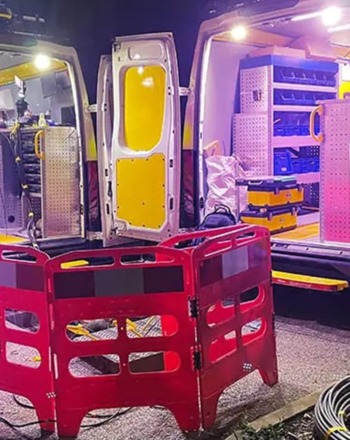We live in a highly digitised world characterised by near-instant data transfer and 24/7 connectivity.
The humble data centre is a major component of this transformation, enabling everything from the internet services and websites we depend on to enterprise cloud computing workflows.
This article explores the journey of data centres through the ages, from early origins to the present day.
The Beginning
To understand data centres, we have to head back to the 1940s and 1950s when larger computers first started evolving.
World War 2 – including the work of computer scientists at the code-breaking facility Bletchley Park in Buckinghamshire – rapidly accelerated the field.
Primitive data centres were colossal and used to execute large-scale computations for business enterprises and government entities.
The equipment present during this era was not only exorbitantly costly but also had a huge appetite for energy, and it wasn’t particularly reliable.
- Inception of Programming: This era marked the start of programming languages, as computers required specific instructions to perform calculations.
- Security and Privacy Concerns: With data centralised in large computers, security began emerging as a concern, although not to the extent it is today.
- Limited Accessibility: Computers and data processing were a luxury, available to very few, shaping a competitive edge in various fields.
The Internet Era
The 1990s heralded a transformative era in the world of data centres. With the internet rolling out to the masses, this period saw data centres evolving and adapting rapidly to accommodate the surging demand for web hosting and many internet services.
Data technology shifted from mainframe-centric architecture to client-server models designed for running workloads over the internet.
- Dot-com Boom: This period saw a surge in internet startups and a new wave of entrepreneurship. Silicon Valley became a tech hotspot, which it remains today.
- Widespread Adoption: As internet access spread to households, the demand for online services surged, necessitating more robust data processing and storage solutions.
- Globalisation of Services: The internet era enabled businesses to operate globally, transcending geographical boundaries and creating 24/7 data uptime, driving data centre development.
New Millennium
The turn of the millennium and early 2000s triggered the rise of wireless services and modernisation of the internet. Dial-up became a thing of the past, with faster broadband connections becoming widespread.
Within years, data centres could host numerous virtual servers on a single physical server, reducing hardware expenses. This lowered the bar to digital transformation.
The early 2000s also established what we now know as “Big Tech”, with behemoths like Google, Amazon, and Microsoft becoming household names. These companies invested heavily in data centres, for which they remain world leaders today.
- Acceleration of Innovation: The 2000s saw rapid technological innovation, making wireless connectivity cheaper and quicker.
- Data as a Commodity: The value of data started becoming more apparent, with businesses investing heavily in data processing and storage capabilities.
- Focus on Efficiency: With the proliferation of data, there was a noticeable shift towards optimising resource utilisation and improving the energy efficiency of data centres.
Cloud & Edge
In the 2010s, the cloud computing revolution further evolved these technologies.
Cloud computing enables businesses to access computing resources via the internet.
This further pushed network and data infrastructure evolutions that delivered scalable, economically efficient computing solutions.
Parallel to the rise of cloud computing, edge computing emerged as a critical technology, bringing data processing capabilities closer to the locations where data is generated. This has been instrumental in building large-scale IoT systems, e.g. for manufacturing and industrial purposes.
- Data Democratisation: Cloud computing levelled the playing field, giving smaller businesses access to computational resources once available only to large enterprises.
- Decentralisation: Edge computing introduced a paradigm shift towards decentralised data processing, reducing latency for real-time applications.
- IoT Integration: This era saw the integration of IoT devices with data centres, expanding the network of connected devices and generating vast amounts of data for processing.
The Future of Data Centres
Looking ahead, we are witnessing an explosion in digital workloads using artificial intelligence (AI) and machine learning (ML) technology. This has massively increased data centre workloads, which now collectively use as much power as a small country.
The industry is also emphatically adopting renewable energy sources and exploring innovative cooling technologies to mitigate the environmental impact of their operations.
- Sustainability Focus: There is an increasing emphasis on making data centres more sustainable, reducing their carbon footprint and overall environmental impact.
- AI and ML Integration: Artificial Intelligence and Machine Learning are becoming integral to data processing, enabling more intelligent and efficient data centres.
- Exponential Data Growth: The digital universe is expanding at an unprecedented rate, with data centres at the core of this growth, processing and storing vast quantities of data.
Data Centre Connectivity with Glide
Glide offers cutting-edge connectivity solutions tailored to meet modern data centres' unique demands.
Glide’s extensive suite of services encompasses everything from dedicated internet access to networking solutions, ensuring that data centres operate at peak performance.
With our commitment to innovation, Glide’s team of experts works tirelessly to deliver top-tier connectivity solutions, ensuring seamless operations and optimal performance for data centres.
In choosing Glide, businesses are selecting a partner committed to driving the future of data centre connectivity, ensuring they are well-equipped to navigate the complexities of today’s digital landscape.


















































































































